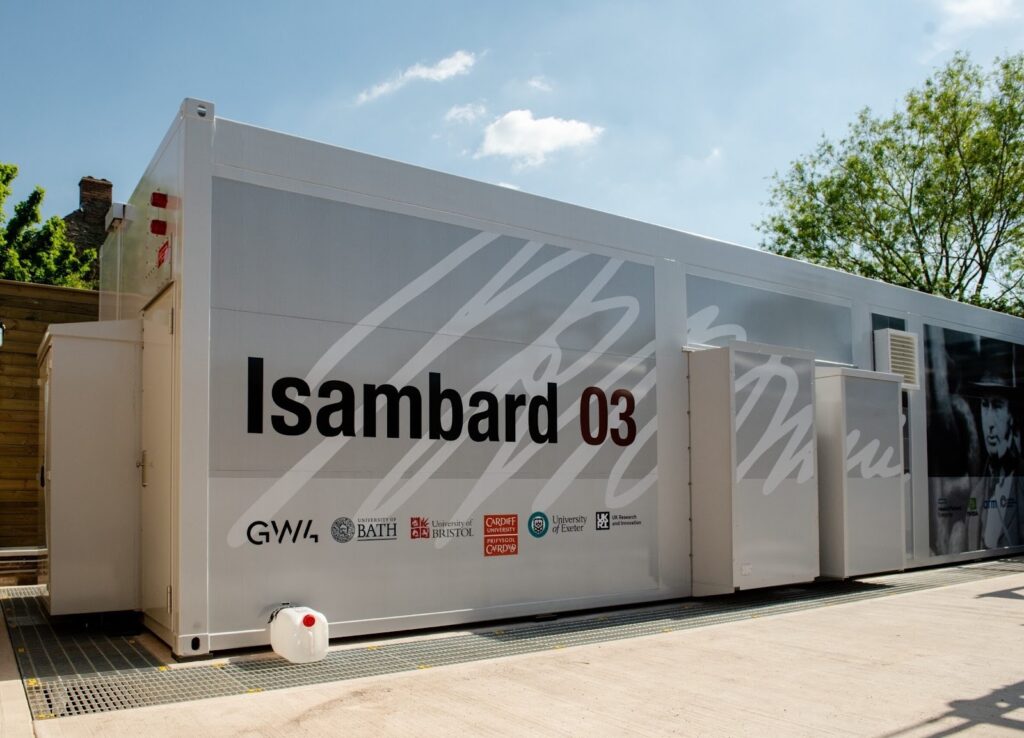The UK has switched on Isambard-AI near Bristol, a national AI supercomputer designed to give researchers and businesses access to high-end compute without relying solely on private hyperscale clouds. Together with Cambridge’s Dawn system, it anchors the UK’s AI Research Resource, a programme that aims to widen access to state-of-the-art hardware and shorten the path from lab breakthroughs to consumer-facing products. The stakes are simple. If compute is the fuel of modern AI, will this new public pump actually change the day-to-day experience of maps, photos, streaming, health tools and climate-aware services on your phone?
What Isambard-AI is, in plain English
Isambard-AI is built on HPE’s Cray EX platform and uses 5,448 Nvidia GH200 Grace Hopper superchips. Each GH200 pairs a CPU with a high-bandwidth GPU on one module, which lowers the cost of moving data between memory and processor. The system sits on a Slingshot 11 interconnect and has nearly 25 petabytes of fast storage tuned for AI training. In UK terms, it is the flagship node of the AI Research Resource, with Cambridge’s Dawn acting as a sister capability.
Two practical context points matter. First, the facility draws on about 5 megawatts of power and represents a capital outlay of roughly £225 million, which signals long-term commitment and explains why scheduling, efficiency and energy-aware software will become part of the UK conversation about AI. Second, public access is a feature, not a footnote.
Where you may feel it first: changes inside everyday apps
When compute bottlenecks ease, developers can ship features that were previously too expensive or too slow to train. Expect three visible shifts over the next product cycles.
- Personalisation without bloat. More powerful and cheaper pre-training runs make it viable to release smaller on-device models that inherit knowledge from larger national models. Result: crisper text predictions, more accurate voice assistants, and photo tools that recognise your own context while keeping data local.
- Better multimodal search. Training pipelines that fuse text, image, audio and geospatial data become practical for mid-sized teams. You should see improved “find this recipe from a photo” features, smarter transcription and summarisation inside messaging, and more precise object search in camera apps.
- Faster iteration. Startups can try several architectures for a feature rather than only one, then A/B test the best candidate in weeks instead of quarters.
Behind the scenes, more training budgets also mean renewed attention to bias and robustness testing, because richer evaluation suites can be run as part of the standard release cadence rather than as one-off reports. In healthcare-adjacent apps, for instance.
Health, climate, media: concrete startup playbooks
The UK has been clear that this infrastructure is not just for science papers. It is supposed to feed new products and services.
Health. Public launch coverage highlighted use cases from improved prostate cancer scanning to earlier anomaly detection in imaging. The significance for startups is not that an app will diagnose conditions on your phone tomorrow, but that training foundational medical models on de-identified datasets becomes affordable if access time is won.
Climate. Dawn’s teams have flagged climate and clean-energy modelling as near-term beneficiaries of national compute. For consumer apps, the knock-on is better local forecasts, personalised air-quality nudges, and route planners that combine live emissions data with traffic and weather to minimise fuel or battery drain.
Media. Generative tools are already in your camera roll and editing apps. Access to larger pre-training runs means better text-to-image fidelity, fewer artefacts, and more controllable style transfer.
What changes for small teams: access, cost, cadence
Isambard-AI is not a free-for-all. It is an allocation-based system with proposals, queues and usage reporting. That said, several differences from a purely commercial cloud workflow are worth noting.
- Lower capital lock-in. You can win time for exploratory training runs without signing a multi-year GPU reservation. That lets you answer the question “does this architecture work at scale” before spending heavily elsewhere.
- Data-governed pathways. Public facilities often bring standard templates for data handling, red-team testing and model documentation. That formalism reduces risk when you later sell into regulated customers.
- Cross-pollination. Co-location with academics and other startups leads to shared baselines and evaluation suites, which can raise quality while reducing duplicated effort.
For media utilities and productivity tools, this shows up in subtle quality improvements: denoising that preserves texture, upscalers that respect skin tones, and smarter mobile pipelines that bridge device and cloud. In those pipelines, it is common to move between formats for speed and storage reasons, and this is where a developer might benchmark workflows that include a png to jpg converter as part of a batch export before on-device inference. The point is not the converter itself, but the ability to profile the entire chain under varied loads and choose the best compromise for latency and battery life.
On the access side, the government has framed Isambard-AI and Dawn as a step change in sovereign compute, with additional funding to lift capacity over a five-year horizon. For startups, that means the window is multi-year, not a one-off pilot. Planning a product roadmap around one or two high-stakes training cycles per year becomes realistic, and those cycles can underpin features that matter to ordinary users: better speech diarisation in note-taking, cleaner low-light photography, and more responsive AR try-ons.
There is also a skills dividend. Working on national systems builds capacity in distributed training, checkpointing and reliability engineering, which tends to diffuse across the ecosystem as engineers switch jobs. Over time, that know-how translates into smoother app updates.
Guard-rails, fairness and provenance

Bigger models do not automatically mean better outcomes. The UK build-out is happening alongside a wider policy push on AI safety and consumer protection.
- Bias audits at scale. With more compute, teams can run larger, more diverse test suites. Expect pressure to publish disaggregated performance metrics, not just headline accuracy.
- Content provenance. As generative features multiply in photo and video apps, public institutions are well placed to pilot watermarking and C2PA-style metadata standards so users can tell what is synthetic.
- Responsible access. Allocation frameworks can prioritise projects with clear societal value or strong governance plans, which helps manage reputational risk for young companies.
Health examples already show the contours of this approach, from improving skin-cancer detection across diverse skin tones to designing public datasets that reduce false positives.
What to watch over the next 12 months
The government and partners have followed a multi-year plan to expand public compute and integrate national centres. For product builders, three milestones will shape what ships to users.
- Access scale. How quickly UKRI calls expand and whether industry allocations grow beyond pilots. An open, no-deadline gateway route already exists, which is a promising signal for cadence.
- Ecosystem signals. Will we see tooling, documentation and reference datasets that make it easy for SMEs to reproduce strong baselines, not just flagship research?
- Funding continuity. The current push sits within a broader pledge to lift national capacity and reduce dependence on foreign compute. Watch the size and timing of new allocations and how they link to regional centres.
If the pieces line up, the consumer benefit should be tangible rather than abstract: apps that start faster, search that understands what you mean without lots of taps, and creative tools that feel like they read your mind without scraping your data.
Conclusion
Isambard-AI is not a magic wand that transforms your home screen overnight. It is, however, a practical lever that can make ambitious features viable for more than just the biggest firms. By lowering the barrier to large-scale training and by formalising routes for UK startups to access compute, the UK has set the stage for quieter but meaningful improvements in the apps you use daily. The smart move for startups is to plan one or two experimental training cycles, prepare data and governance now, and design product bets that translate raw compute into features users actually notice: faster, fairer, more reliable experiences that respect battery, privacy and taste.
FAQ
When will ordinary users notice changes?
Incrementally over the next few release cycles. Features like better low-light photo enhancement, improved speech transcription and smarter multimodal search will roll out as teams complete training and evaluation on national systems.
Can startups really get access, or is this just for universities?
The AI Research Resource includes an open gateway route for UK-based researchers from academia and industry. Allocations are competitive, but SMEs can apply for compute time without long cloud commitments.
How powerful is the system, in practical terms?
Isambard-AI uses 5,448 Nvidia GH200 superchips and, with Cambridge’s Dawn, contributes to around 23 AI exaFLOPS of national capacity. That level of throughput makes large-scale pre-training and evaluation viable for more UK teams.
What about costs and energy use?
Reports cite roughly £225 million in capital costs and about 5 MW of power draw for Isambard-AI, which underscores why efficiency and utilisation will be closely monitored.
Is this replacing the cloud?
No. It complements commercial clouds. Many teams will develop on public infrastructure, then deploy production workloads on a mix of cloud and edge depending on latency, cost and data-governance needs.



